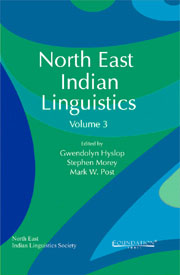Book contents
- Frontmatter
- Contents
- About the Contributors
- Foreword
- A Note from the Editors
- The View from Manipur
- The Sal Group
- Tibeto-Burman Nominalization
- Tani
- 9 Topographical Deixis and the Tani Languages of North East India
- 10 Morphosyntactic Variation in the Pagro and Sa:jaŋ Dialects of the Mising Community
- Eastern Indo-Aryan
- Austroasiatic
10 - Morphosyntactic Variation in the Pagro and Sa:jaŋ Dialects of the Mising Community
from Tani
Published online by Cambridge University Press: 26 October 2011
- Frontmatter
- Contents
- About the Contributors
- Foreword
- A Note from the Editors
- The View from Manipur
- The Sal Group
- Tibeto-Burman Nominalization
- Tani
- 9 Topographical Deixis and the Tani Languages of North East India
- 10 Morphosyntactic Variation in the Pagro and Sa:jaŋ Dialects of the Mising Community
- Eastern Indo-Aryan
- Austroasiatic
Summary
Introduction
Mising is listed in the Indian constitutional order of Scheduled Tribes, 1950, as Miri. When and how the name Miri came to represent the Misings remains a matter of conjecture. In fact, “never a tribe known as Miri existed before”, claims Dr N. C. Pegu. In the words of Prasad (1991: 4), the word Miri is derived from ami ‘man’ + iri ‘virtue’ = miri ‘virtuous man’. Today, the Mising speakers consider the name Miri to be derogatory and in fact refer to themselves as Mising. Hence, they are now known by this name for all purposes. Sun, in his (1993) study of Tani languages, states that the term Abor-Miri-Dafla, composed of names of the three major tribal groups speaking these languages, must be discarded, since the outdated exonyms it is based on are now resented by native speakers. These terms are no longer accepted or widely used in North East India, having been replaced by the names Adi, Mising, and Nyishi, respectively.
The Mising people are believed to have once been hill dwellers, and to have lived in the hilly tracts of modern-day Arunachal Pradesh. The precise date and circumstances of entry of the Misings to the Brahmaputra Valley is not known. There are many controversies regarding the time of their settlement In Assam as well as in the adjoining plains of Arunachal Pradesh. N. C. Pegu and Dimbeswar Doley have estimated the Mising migration to have taken place around the time of the Ahom invasion in the early 13 century AD (Doley 2008: 48), although this has not yet been independently confirmed.
- Type
- Chapter
- Information
- North East Indian Linguistics , pp. 155 - 170Publisher: Foundation BooksPrint publication year: 2011
- 1
- Cited by



